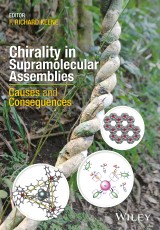Details

Chirality in Supramolecular Assemblies
Causes and Consequences1. Aufl.
|
134,99 € |
|
| Verlag: | Wiley |
| Format: | EPUB |
| Veröffentl.: | 03.01.2017 |
| ISBN/EAN: | 9781118867310 |
| Sprache: | englisch |
| Anzahl Seiten: | 432 |
DRM-geschütztes eBook, Sie benötigen z.B. Adobe Digital Editions und eine Adobe ID zum Lesen.
Beschreibungen
<p>Supramolecular chemistry deals with the organisation of molecules into defined assemblies using non-covalent interactions, including weaker and reversible interactions such as hydrogen bonds, and metal-ligand interactions. The aspect of stereochemistry within such chemical architectures, and in particular chirality, is of special interest as it impacts on considerations of molecular recognition, the development of functional materials, the vexed question of homochirality, nanoscale effects of interactions at interfaces, biocatalysis and enzymatic catalysis, and applications in organic synthesis.</p> <p><i>Chirality in Supramolecular Assemblies</i> addresses many of these aspects, presenting a broad overview of this important and rapidly developing interdisciplinary field. Topics covered include:</p> <ul> <li>Origins of molecular and topological chirality</li> <li>Homochirogenesis</li> <li>Chirality in crystallinity</li> <li>Host-guest behavior</li> <li>Chiral influences in functional materials</li> <li>Chirality in network solids and coordination solids</li> <li>Aspects of chirality at interfaces</li> <li>Chirality in organic assemblies</li> <li>Chirality related to biocatalysis and enzymes in organic synthesis.</li> </ul> <p>This book is a valuable reference for researchers in the molecular sciences, materials science and biological science working with chiral supramolecular systems. It provides summaries and special insights by acknowledged international experts in the various fields.</p>
List of Contributors xi <p>Preface xiii</p> <p><b>1 Principles of Molecular Chirality 1</b><br /><i>Jean?]Claude Chambron and F. Richard Keene</i></p> <p>1.1 General Introduction 1</p> <p>1.2 Geometrical Chirality 2</p> <p>1.3 Topological Chirality 25</p> <p>1.4 Conclusion 39</p> <p>References 39</p> <p><b>2 Homochirogenesis and the Emergence of Lifelike Structures 44</b><br /><i>Pedro Cintas</i></p> <p>2.1 Introduction and Scope 44</p> <p>2.2 The Racemic State: Mirror Symmetry Breaking 45</p> <p>2.3 Asymmetric Oligomerization 49</p> <p>2.4 Biochirality in Active Sites 58</p> <p>2.5 Conclusions 61</p> <p>Acknowledgements 61</p> <p>References 61</p> <p><b>3 Aspects of Crystallization and Chirality 65</b><br /><i>Roger Bishop</i></p> <p>3.1 Introduction 65</p> <p>3.2 Crystal Space Groups 65</p> <p>3.3 Fundamentals of Crystallization for a Racemic Mixture 69</p> <p>3.4 More Complex Crystallization Behavior 71</p> <p>3.5 Multiple Crystal Forms 74</p> <p>3.6 Conglomerates Revisited 85</p> <p>References 90</p> <p><b>4 Complexity of Supramolecular Assemblies 94</b><br /><i>Jonathan A. Kitchen and Philip A. Gale</i></p> <p>4.1 Introduction 94</p> <p>4.2 Generating Supramolecular Chirality through Assembly of Achiral Components 96</p> <p>4.3 Enantioselective Supramolecular Assemblies 121</p> <p>4.4 Conclusions and Future Outlook 134</p> <p>References 134</p> <p><b>5 Chirality in the Host?]Guest Behaviour of Supramolecular Systems 142</b><br /><i>Nicholas H. Evans and Paul D. Beer</i></p> <p>5.1 An Introduction to Chiral Recognition and its Importance 142</p> <p>5.2 Chiral Hosts for Chiral Guests 143</p> <p>5.3 Conclusions: Summary and Future Directions 155</p> <p>References 156</p> <p><b>6 Chiral Influences in Functional Molecular Materials 159</b><br /><i>David B. Amabilino</i></p> <p>6.1 Introduction 159</p> <p>6.2 Functional Molecular Materials in Different States 161</p> <p>6.3 Switching 168</p> <p>6.4 Conducting Materials 171</p> <p>6.5 Magnetic Materials 173</p> <p>6.6 Sensors 177</p> <p>6.7 Conclusions and Outlook 180</p> <p>Acknowledgements 181</p> <p>References 181</p> <p><b>7 Chirality in Network Solids 190</b><br /><i>David R. Turner</i></p> <p>7.1 Introduction 190</p> <p>7.2 Chirality in Inorganic Network Solids 191</p> <p>7.3 Synthesis of Chiral Coordination Polymers 192</p> <p>7.4 Applications of Chiral Coordination Polymers 207</p> <p>7.5 Summary and Outlook 209</p> <p>References 210</p> <p><b>8 Chiral Metallosupramolecular Polyhedra 218</b><br /><i>Jack K. Clegg and John C. McMurtrie</i></p> <p>8.1 Introduction 218</p> <p>8.2 Basic Design Principles 219</p> <p>8.3 Chiral Polyhedra from Achiral Components 221</p> <p>8.4 Stereochemical Communication 231</p> <p>8.5 Resolution of Racemic Metallo?]Supramolecular Polyhedra 236</p> <p>8.6 Chiral Polyhedra from Chiral Molecular Components 239</p> <p>8.7 Conclusions and Outlook 250</p> <p>References 251</p> <p><b>9 Chirality at the Solution/Solid?]State Interface 257</b><br /><i>Iris Destoop and Steven De Feyter</i></p> <p>9.1 Self?]Assembly at the Solution / Solid?]State Interface 257</p> <p>9.2 Chirality Expression at the Solution / Solid?]State Interface 258</p> <p>9.3 Chiral Induction / Amplification at the Solution / Solid?]State Interface 266</p> <p>9.4 Towards Applications 278</p> <p>9.5 Conclusions 282</p> <p>References 282</p> <p><b>10 Nanoscale Aspects of Chiral Nucleation and Propagation 285</b><br /><i>Edward G. Latter and Rasmita Raval</i></p> <p>10.1 Introduction 285</p> <p>10.2 Systems of Discussion 288</p> <p>10.3 Conclusions 303</p> <p>References 304</p> <p><b>11 Chirality in Organic Hosts 307</b><br /><i>Daniel Fankhauser and Christopher J. Easton</i></p> <p>11.1 Introduction 307</p> <p>11.2 Chiral Hosts in Analytical Applications 307</p> <p>11.3 Chiral Hosts in Asymmetric Reactions 313</p> <p>11.4 Conclusion 337</p> <p>Acknowledgements 338</p> <p>References 338</p> <p><b>12 Chirality Related to Biocatalysis and Enzymes in Organic Synthesis 343</b><br /><i>Declan P. Gavin and Anita R. Maguire</i></p> <p>12.1 Introduction 343</p> <p>12.2 Biocatalysis 344</p> <p>12.3 Biocatalytic Methodologies: Kinetic/Dynamic Kinetic Resolution and Asymmetric Transformations/Chemoselective Desymmetrizations 348</p> <p>12.4 Optimization of Biocatalyst Performance 351</p> <p>12.5 Protein Engineering 352</p> <p>12.6 Hydrolysis/Reverse Hydrolysis 356</p> <p>12.7 Redox Reactions 366</p> <p>12.8 C?]C and Other C?]X Bond Formation 380</p> <p>12.9 Future and Outlook 385</p> <p>References 385</p> <p>Index 407</p>
<p><b>Emeritus Professor F. Richard Keene</b><br />Adjunct Professor of Chemistry, School of Pharmacy & Molecular Sciences, James Cook University, Australia and Department of Chemistry, University of Canterbury, New Zealand. Honorary Visiting Research Fellow, School of Chemistry & Physics, University of Adelaide<br />Richard Keene is an acknowledged international authority on stereochemistry in coordination chemistry - and significantly, in the control of stereochemistry within polymetallic supramolecular assemblies - and has over the last decade has published widely on (i) its effect on intramolecular electron and energy transfer in such assemblies, and (ii) its influence on sequence- and structure-selectivity in the interaction of such complexes with nucleic acids, and their cytotoxicity to cancer cells and bacteria. He has over 160 publications (h-index 44), as well 6 chapters in monographs and a patent.</p>
















